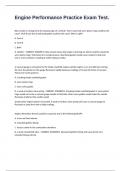Exam (elaborations)
Engine Performance Practice Exam Test.
- Course
- Institution
Engine Performance Practice Exam Test. Blue smoke is coming from the exhaust pipe of a vehicle. Tech A says that worn piston rings could be the cause. Tech B says that a bad head gasket could be the cause. Who is right? A. Tech A B. Tech B C. Both D. Neither - CORRECT ANSWER A. Blue smoke...
[Show more]



